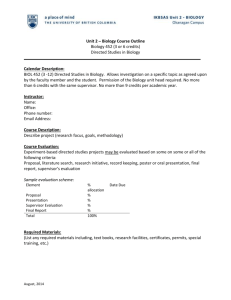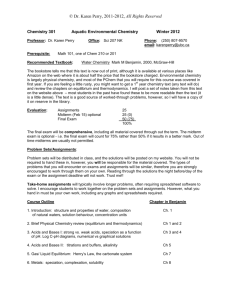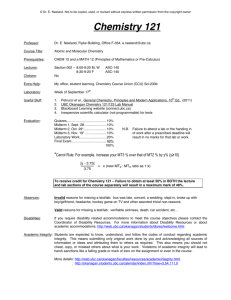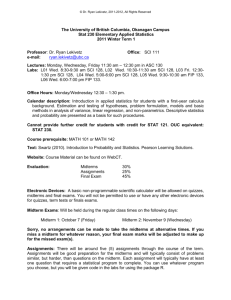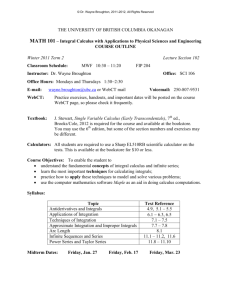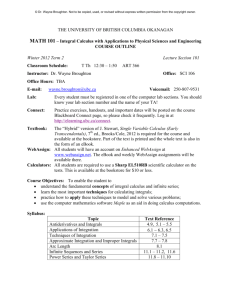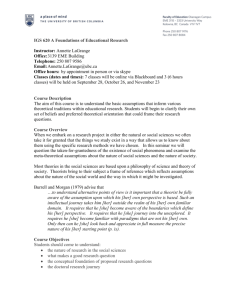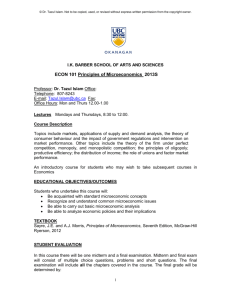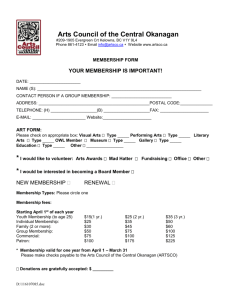CHEM 121-003
advertisement
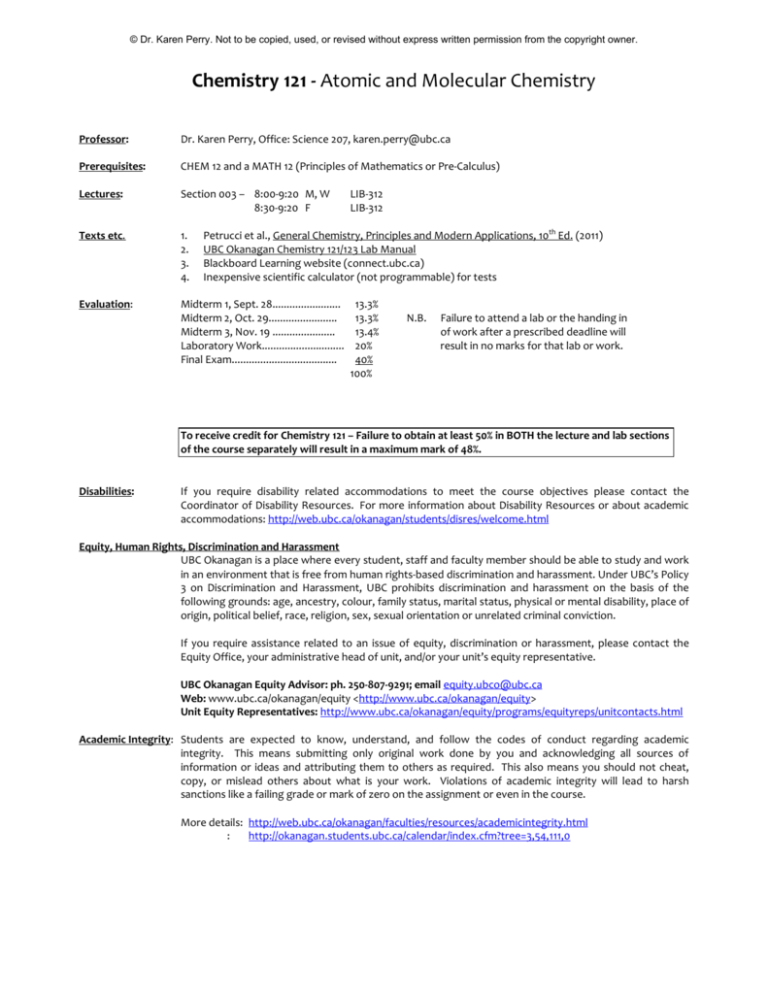
© Dr. Karen Perry. Not to be copied, used, or revised without express written permission from the copyright owner. Chemistry 121 - Atomic and Molecular Chemistry Professor: Dr. Karen Perry, Office: Science 207, karen.perry@ubc.ca Prerequisites: CHEM 12 and a MATH 12 (Principles of Mathematics or Pre-Calculus) Lectures: Section 003 – 8:00-9:20 M, W 8:30-9:20 F Texts etc. 1. 2. 3. 4. Evaluation: Midterm 1, Sept. 28........................ Midterm 2, Oct. 29........................ Midterm 3, Nov. 19 ...................... Laboratory Work............................. Final Exam..................................... LIB-312 LIB-312 Petrucci et al., General Chemistry, Principles and Modern Applications, 10th Ed. (2011) UBC Okanagan Chemistry 121/123 Lab Manual Blackboard Learning website (connect.ubc.ca) Inexpensive scientific calculator (not programmable) for tests 13.3% 13.3% 13.4% 20% 40% 100% N.B. Failure to attend a lab or the handing in of work after a prescribed deadline will result in no marks for that lab or work. To receive credit for Chemistry 121 – Failure to obtain at least 50% in BOTH the lecture and lab sections of the course separately will result in a maximum mark of 48%. Disabilities: If you require disability related accommodations to meet the course objectives please contact the Coordinator of Disability Resources. For more information about Disability Resources or about academic accommodations: http://web.ubc.ca/okanagan/students/disres/welcome.html Equity, Human Rights, Discrimination and Harassment UBC Okanagan is a place where every student, staff and faculty member should be able to study and work in an environment that is free from human rights-based discrimination and harassment. Under UBC’s Policy 3 on Discrimination and Harassment, UBC prohibits discrimination and harassment on the basis of the following grounds: age, ancestry, colour, family status, marital status, physical or mental disability, place of origin, political belief, race, religion, sex, sexual orientation or unrelated criminal conviction. If you require assistance related to an issue of equity, discrimination or harassment, please contact the Equity Office, your administrative head of unit, and/or your unit’s equity representative. UBC Okanagan Equity Advisor: ph. 250-807-9291; email equity.ubco@ubc.ca Web: www.ubc.ca/okanagan/equity <http://www.ubc.ca/okanagan/equity> Unit Equity Representatives: http://www.ubc.ca/okanagan/equity/programs/equityreps/unitcontacts.html Academic Integrity: Students are expected to know, understand, and follow the codes of conduct regarding academic integrity. This means submitting only original work done by you and acknowledging all sources of information or ideas and attributing them to others as required. This also means you should not cheat, copy, or mislead others about what is your work. Violations of academic integrity will lead to harsh sanctions like a failing grade or mark of zero on the assignment or even in the course. More details: http://web.ubc.ca/okanagan/faculties/resources/academicintegrity.html : http://okanagan.students.ubc.ca/calendar/index.cfm?tree=3,54,111,0 © Dr. Karen Perry. Not to be copied, used, or revised without express written permission from the copyright owner. Course Outline Topic 1 Review 1.0 1.1 1.2 1.3 1.4 1.5 1.6 Topic 2 Topic 5 Topic 6 Chapter 6 Empirical approach to the gas laws, Boyle, Charles. The kinetic-molecular theory of gases (qualitatively). Ideal vs. real gases. Graham's Law of Effusion, Dalton's Law of Partial Pressures. Solids and Liquids (8-9 hours) 6.0 6.1 6.2 6.3 6.4 Chapters 10,11 The ionic and covalent bond types; properties of covalent and ionic cmpds. Lewis structures, octet rule (and exceptions), formal charges, resonance Molecular geometry: the VSEPR approach Bonding: valence bond theory, hybridization, geometry, s/p bonds, bond energies/lengths Bonding: molecular orbital theory – diatomic molecules (H to Ne), bond order The Gaseous State (4-5 hours) 5.0 5.1 5.2 5.3 Chapters 2,8,9 Nature of light, elementary spectroscopy. The quantum theory and the Bohr atom. Quantum mechanics; the orbital concept. Electron configurations of atoms; the Aufbau process; electronic structures to Ca. The periodic table: its historical development. The periodic table as a reflection of atomic structure; periodic trends. Chemical Bonding (13-14 hours) 4.0 4.1 4.2 4.3 4.4 Chapters 3-4 The weight laws. Atomic/molecular masses, isotopes, mass spectroscopy The mole Inorganic formulae and nomenclature % Composition, combustion analysis Empirical and molecular formulae. Mole and mass relationships from balanced chemical equations. Yields; % yields; limiting reagents. Volumetric and gravimetric analyses Analysis of mixtures. Atomic Structure and Periodicity (13-14 hours) 3.0 3.1 3.2 3.3 3.4 3.5 Topic 4 Introduction Scientific method Physical quantities: measurement, units, sig. figs., unit conversion Chemistry and the nature of matter Symbols: elements, compounds Atoms, molecules and ions Empirical and molecular formulae From Atoms to Stoichiometry (5-6 hours) 2.0 2.1 2.2 2.3 2.4 2.5 2.6 2.7 2.8 2.9 Topic 3 Chapters 1-3 Four types of crystalline solids. Their properties using bond types. Solid, liquid and vapour equilibria; the phase diagram. Solubility: saturation, unsaturation, supersaturation; concentration units Effects of temperature and pressure. Colligative properties, vapour pressure, BP, FP, osmotic pressure. Chapters 12,13 © Dr. Karen Perry. Not to be copied, used, or revised without express written permission from the copyright owner.
